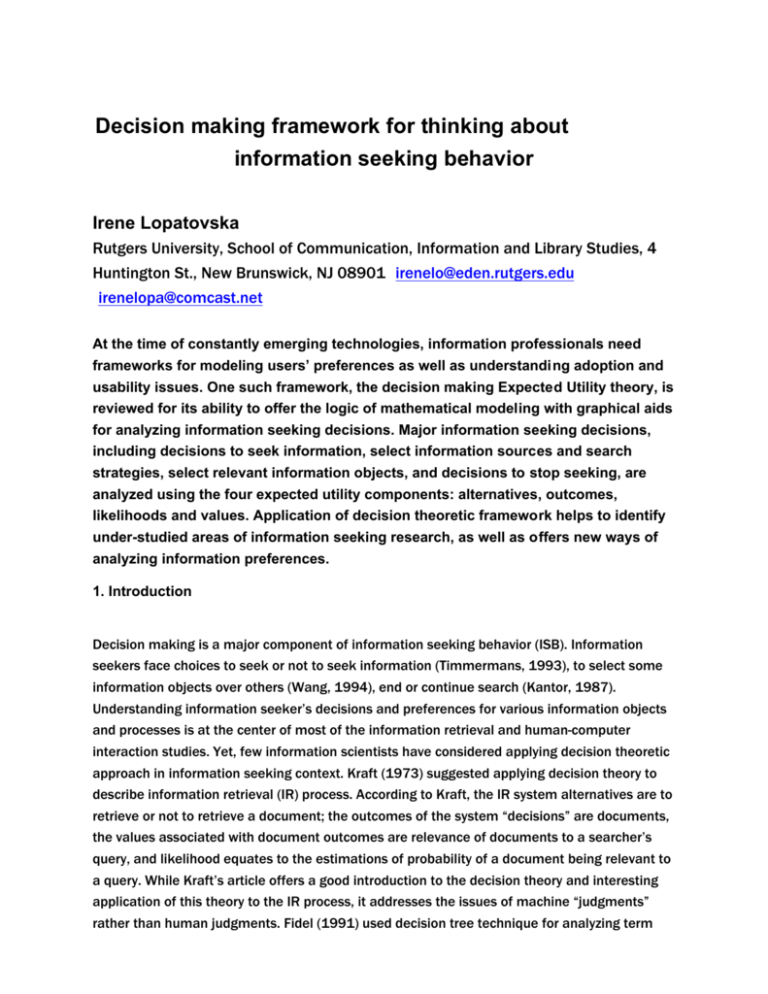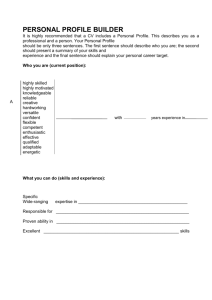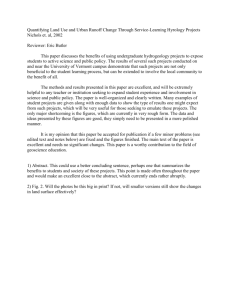Decision making framework for thinking about information seeking
advertisement

Decision making framework for thinking about information seeking behavior Irene Lopatovska Rutgers University, School of Communication, Information and Library Studies, 4 Huntington St., New Brunswick, NJ 08901 irenelo@eden.rutgers.edu irenelopa@comcast.net At the time of constantly emerging technologies, information professionals need frameworks for modeling users’ preferences as well as understanding adoption and usability issues. One such framework, the decision making Expected Utility theory, is reviewed for its ability to offer the logic of mathematical modeling with graphical aids for analyzing information seeking decisions. Major information seeking decisions, including decisions to seek information, select information sources and search strategies, select relevant information objects, and decisions to stop seeking, are analyzed using the four expected utility components: alternatives, outcomes, likelihoods and values. Application of decision theoretic framework helps to identify under-studied areas of information seeking research, as well as offers new ways of analyzing information preferences. 1. Introduction Decision making is a major component of information seeking behavior (ISB). Information seekers face choices to seek or not to seek information (Timmermans, 1993), to select some information objects over others (Wang, 1994), end or continue search (Kantor, 1987). Understanding information seeker’s decisions and preferences for various information objects and processes is at the center of most of the information retrieval and human-computer interaction studies. Yet, few information scientists have considered applying decision theoretic approach in information seeking context. Kraft (1973) suggested applying decision theory to describe information retrieval (IR) process. According to Kraft, the IR system alternatives are to retrieve or not to retrieve a document; the outcomes of the system “decisions” are documents, the values associated with document outcomes are relevance of documents to a searcher’s query, and likelihood equates to the estimations of probability of a document being relevant to a query. While Kraft’s article offers a good introduction to the decision theory and interesting application of this theory to the IR process, it addresses the issues of machine “judgments” rather than human judgments. Fidel (1991) used decision tree technique for analyzing term selection routines of online searchers. Kantor (1986) suggested applying decision theoretic approach for understanding IR user stopping behavior. Blackshaw and Fishhoff (1988) applied decision theory in the analysis of online searching behavior. All the above mentioned studies suggest a narrow application of the decision theories to the specific ISB domains. A broad application of the decision making framework in the ISB research can offer quantitative modeling techniques for understanding seekers’ preferences of information objects and processes. This paper illustrates how some of the ISB phenomena can be viewed through the lens of decision making theory and suggests directions for future research. 2. Decision making components This paper refers to a normative Expected Utility theory developed by von Neumann and Morgenstern (1967). While normative models are criticized for not accurately describing behavior (Gigerenzer, 2004), they have a virtue of being formally explicit and tractable, and can be used for making quantitative predictions in various contexts (Sanfey, Loewenstein, McClure, & Cohen, 2006). Most of the ISB research is quite successful in describing various information seeking decisions phenomena. However, it is lacking a benchmark theory that would unify scattered concepts, discriminate between normative (e.g., common, beneficial to seeker) and deviant (e.g., exceptional, detrimental) behavior, and offer ways to quantify, model and predict behavior. Decision making theories attempt to describe and model situations in which a choice is made using four major components: Alternatives or all the strategies available to a decision maker for a given situation Outcomes or potential consequence of the decision if a certain alternative is chosen; Likelihood or probability of various outcomes based on the states of nature; Values that are associated with outcomes and are based on a formula or a cognitive process (Roberts & Sonnenberg, 2000). Figure 1. Decision tree (from Huber, 1997). We illustrate the connection between decision components using a decision tree - one of the common visual modeling techniques in decision research. In Figure 1 (Huber, 1997), the square on the left represents a choice node; it is the start of the decision making process when decision maker has full control over the alternatives. Branches represent different alternatives which lead to different outcomes. Selection of an alternative narrows the outcome range to the branches below the chosen alternative. . Outcomes depend on various events, or states of nature, which decision maker cannot control (chance node is represented by a circle). Different states of nature determine probabilities of the outcome occurrences. Each outcome is associated with a value a decision maker assigns to it. We can draw a simple ISB process using the decision tree technique. Lets imagine that a person has an information need. The alternatives for addressing the need include 1) seeking information on the internet, 2) seeking information in a library, or 3) not seeking information at all. Any alternative can lead to finding or not finding the needed information, however, the likelihood of finding information varies between alternatives. For example, the probability of finding information on the internet is 50%, finding it in the library is 80%, and finding it without seeking is 1%. Note, that the probabilities within alternative’s branches should add up to 100%. For example, if probability of finding information in a library is 80%, the probability of not finding it in a library should be 20% so that the probability of all the states in “seek information in the library” alternative adds up to 100% (80%+20%=100%). Note as well, that the probabilities of finding information across the entire search decision tree need not add-up to one if we can be expected to obtain the correct information from more than one source. The outcomes of the decisions represent desirability of goals that decision maker wants to achieve (Baron, 2000b). The goal in our example could be obtaining the most accurate information with the least effort. The outcomes are associated with utility (u), a measure of extend of goal achievement (Baron, 2000b). The hassle of finding information by going to a library is significant. However, if going to the library is the best way to obtain the most accurate and complete information then the utility of the outcome of going to the library and finding information represents the difference between the value of quality information and the hassle of obtaining it (u=.8). Using similar logic, we assign utility values to all outcomes: utility of finding medium quality information with medium effort on the internet is .7, not finding information on the internet is .3, not finding information in a library after making an effort of going there is .1, utility of finding information without any effort is maximum value of 1, and not finding it without searching is .2. Now we can decide on the best alternative by considering probabilities and desirability of the outcomes. The goodness of alternative is measured in expected utility (EU). It is calculated for each alternative by multiplying the probability of each outcome by its utility, summed across outcomes: where EU stands for expected utility, ui sand pi stand for utility and probability of the ith outcome. The premise of the expected utility theory is that rational decision makers are trying to maximize EU and therefore select options with the highest EU value. In our example, The largest EU value of seeking information in the library (EU=.66) indicates that this choice would be the most optimal, followed by seeking information on the internet (EU=.5) and not seeking information at all (EU=.208). A reader is advised to remember this example throughout the following sections of the paper. Every reference to alternatives, outcomes, likelihoods or values in the context of ISB decisions can be associated with numbers that can be plugged into the model for calculation of the optimal decision, decision with the highest EU value. We used Expected Utility theory to analyze our information seeking choice example. However, there are other decision theories, including Multi-Attribute Decision theory (Baron, 2000a) and Prospect theory (Kahneman & Tversky, 1979). The differences between these theories, including techniques for assessing outcome utilities, likelihoods of outcomes and states of nature, are beyond the scope of this paper. None of the decision making theories accurately describe or predict human behavior 100% of the time. However, normative theories provide a conceptual framework for thinking about behavioral phenomena. 3. Decision making components in information seeking behavior (ISB) Information seekers make decisions at different stages of the seeking process. Based on the information seeking research of Blackshaw and Fishhoff (1988), Wilson (1997) and others, we can identify the following types of decisions: decisions to seek or not to seek information, decisions related to specific search strategies, decisions related to selection of relevant information objects, and decisions to continue or stop seeking information. 3.1 Decisions to seek or not to seek information 3.1.1 Alternatives Alternatives that are available to a person with an information need are “to seek” or “not to seek” information. The variations of these alternatives include to seek information now or to seek it later. Most of the ISB research assumes that when a person faces a gap that prevents her from making sense of a situation (Dervin & Nilan, 1986), an anomalous state of knowledge (Belkin, 1978), need to confirm/ disprove an inconsistent idea (Wildemuth, de Bliek, Friedman, & Miya, 1994), or uncertainty (Repo, 1989; Horne, 1983; Urbany, Dickson, and Wilke, 1989), the preferred alternative is to seek information to bridge the gap, gain knowledge or resolve uncertainty. However, there is some research indicating that seeking information to resolve uncertainty is not always the preferred alternative. Allen (1996) and Wilson (1997) describe situations of health information seeking when individuals prefer not to seek information. One of the explanations for such preference is that once people receive information they will face the burden of selecting a course of action. Another explanation is avoidance of information related to a thread, such as a disease, in a stressful situation. An individual might choose not to seek information, and rely on stereotypes or other heuristics for closing the cognitive gap or resolving uncertainty. Timmermans (1993) and Macrae, Hewston, and Griffiths (1993) found that increased decision complexity and information processing reduces the amount of information seeking and increases reliance on stereotypes’ heuristics. 3.1.2 Outcomes The outcomes of seeking information could be grouped into two general categories: cognitive and tangible. An example of a cognitive outcome would be changed knowledge manifested in new word associations (Belkin, Cool, Stein, & Thiel, 1995), readiness to make a decision (Hirshleifer & Riley, 1992) or readiness to make progress in tasks (Kuhlthau, 1991). The tangible outcomes include research, dissertation, or exam (Saracevic and Kantor (1997); pleasure from learning something new, staying current, educating others or relaxing (Krikelas, 1983; Savolainen, 1995; Rioux, 2005). 3.1.3 Likelihood It is hard to find literature that refers to the likelihood estimations in information seeking judgments. A possible reason for the scarcity of literature is that people in general have difficulty formalizing likelihood estimations, especially in terms of probabilities (Gigerenzer & Hoffrage, 1995). Blackshaw and Fishhoff (1988) point to the fact that online system users might not even address all stages of the decision making process. However, the probability estimations can be inferred from information seekers’ preferences or believes about information seeking success or failure. For instance, Wilson (1996) referrers to cases when a person decides not to seek information because of the lack of belief in personal success. In such case, a person might realize the benefits from seeking information and place high value on the outcome, but estimate very low probabilities of a successful search. The low expected utility of a search (a sum product of the outcome’s value and probability) leads to the choice to not seek the information. In cases when probability estimates of successful information seeking are high enough to contribute to high expected utility values, individuals prefer to engage in information seeking. 3.1.4 Values Discussion about the value of information seeking is linked to the discussion about the value of information. There is no consensus about the nature of information value among information scientists, economists and other researchers dealing with the issue (Bates, 1988; Repo, 1989). However, most of the researchers agree that the value of information derives from its usefulness at present or future times. The value of information seeking can be derived by examining the implications of finding information and addressing the question: does improved knowledge make an individual better or worse off considering the costs of obtaining the information? One of the approaches to estimating the value of information seeking is risk and reward model. Stigler (1961) suggests that decisions to seek information are influenced by evaluations of risks and rewards involved in seeking. Information is sought when the rewards from seeking are higher than from not seeking. The risk is measured in terms of cost, time, and convenience. Godbold (2006) lists more risks that might lower the value of information seeking, among them, emotional risks, physical risks, or political and social risks. The value of seeking and the level of investment in seeking are largely determined by the perceived importance of the task or the decision requiring information (Zach, 2005). 3.2 Decisions related to specific search strategies 3.2.1 Choices of information sources 3.2.1.1 Alternatives There are various alternatives for obtaining information. People can learn from personal communication with professionals, such as financial advisors, physicians. Alternatives include consulting the media, such as television or newspaper (Allen, 1996), a reference desk, electronic references resources, book or film, or purchasing material (Saracevic and Kantor, 1997). 3.2.1.2 Outcomes The outcomes in judgments related to selection of information sources are potential consequences of consulting IR systems, and/or libraries, an expert, purchasing a book or using other source for obtaining information. An example of the desired outcome would be obtaining relevant information at the minimum cost and the maximum convenience. 3.2.1.3 Likelihood Availability and accessibility of sources are two researched criteria pertaining to users’ assessments of probabilities of finding information (Schamber, 1991; Saracevic & Kantor, 1997; Saracevic, 2004). If a system is not accessible or available, the probability of it being useful is low. So even in situations when a user knows that the search of a particular source might be very fruitful (high value search, U = 1), she will not select the source due to its low availability and low total expected utility of the choice. 3.2.1.3 Values There seems to be no literature on a single measure of information source goodness, something that could be compared to the concept of information object utility discussed in section 3.3. However, there is abundant literature on the various aspects contributing to the overall value of information source. Some of these aspects include quality, trust, authority, affective reactions associated with the source (Halpern & Nilan, 1988; Belkin, 1978; Zach, 2005; Auster & Choo, 1991; Palmer, 1991). Other aspects contributing to the evaluation of information sources include time and costs considerations (Taylor, 1986; Marchionini, Plaisant, & Komlodi, in press) and knowledge of the system content (Hert, 1996). 3.2.2 Choices of search tactics 3.2.2.1 Alternatives In the context of the mediated information seeking, alternatives include deciding on different ways to seek an advice: consult informal mediators (e.g., family and friends) or formal mediators (e.g., teachers and librarians) (Kuhlthau, 1993); meeting with mediators face to face, or getting in touch with them using telephone, email or fax. Different formats of the information request, such as formal or information questions, would also be considered alternatives. In the context of human-machine information seeking, alternatives include various strategies of searching for information, and more specific considerations related to query terms selections (Marchionini, 1995; Bates, 1989). The decision theoretic approach is not new to the research in query term formulation. Fidel (1991) used decision tree technique for analyzing term selection routines. Fidel (1991) notes that while query formulation is an intuitive process, searchers use rules that can be mapped onto the formal models. 3.2.2.2 Outcomes In the context of interpersonal information seeking, the outcomes would be consequences of written or verbal expert responses. In the context of IR system interaction, the desired outcome would include relevant information object (e.g., document) or a set of retrieved information objects. Information object outcomes are described in Section 3.3. We did not find literature analyzing information object sets as the outcomes of the search tactic judgments. 3.2.2.3 Likelihood We did not find literature on the estimations of probabilities of success for various search strategies. However, probability estimates can be inferred from the information seeker’s preferences. For example, most of the information seekers would place a high value on an expert advice (Belkin, 1978). However, in some instances the probability of this outcome might be low due to the lack of expert’s availability or approachability, contributing to the low overall expected utility of this strategy. Another example when probability estimates might change the overall preference is the use of Boolean operators. While an online searcher might be aware of the benefits of Boolean operators, she might not believe in her abilities to use them correctly, and consequently avoid using Boolean operators in online search (Savage-Knepshield & Belkin, 1999). 3.2.2.4 Values Discussion about the value of information tactics’ outcomes follows the discussion about the value of information. Information seekers put high value on relevant information that leads to changes in cognitive (Belkin, et al., 1982) and contextual (Harter, 1992) states, and low values on irrelevant information. Individuals select tactics that have high expected utility values derived from high outcome values and/or probabilities. The values of various search terms depend on user preferences for minimal cognitive effort and energy required to formulate the query. The ultimate value of a query is determined by its effectiveness in producing quality information (Wacholder & Lui, 2006). 3.3 Selection of relevant information objects. 3.3.1 Alternatives After conducting a search or inquiring about information, the seeker chooses information that is perceived as the most relevant to the need. The literature on the alternatives such as abstracts or full-text articles is particularly abandoned in the context of information retrieval (Harter, 1992; Mizzaro, 1997; Wang, 1994). 3.3.2 Outcomes The outcomes of selection process are information or information objects that are chosen to address information needs. The outcomes of information selection are not known until information is found, examined and evaluated. An example of a decision tree would include document n1 through nx as alternatives. Each of these alternatives would have “use “or “not-use” branches resuting in outcomes similar to “how better off will I be by using/not using this information”. Selection of relevant objects is an unusual decision since multiple or all alternatives can be considered for use. The uncertain situation of not knowing whether any of the information will be useful contributes to the feeling of anxiety often observed during information seeking (Kuhlthau, 1993). 3.3.3 Likelihood Users’ familiarity with systems and perceptions of their quality contribute to their assessments of probabilities of obtaining useful results. For example, knowledge of system’s recall/precision (Tague-Sutcliffe, 1992), response time, capacity and error rate (Saracevic, 2004) might contribute to high or low probability assessments of quality outcomes. Searcher might not select information objects that are associated with low perceived quality due to the poor authority and/or credibility estimations (Wilson, 1983). Searchers are more likely to select information objects that they deem more likely to be trustworthy and of good quality (Reih, 2002). 3.3.4 Values Research in values of information objects is the most prolific ISB area related to judgment and decision making. The value of information objects is usually associated with its relevance as judged by a searcher (Schamber, 1994). There are two treatments of relevance (or relevance-like) concepts in the literature: multi-dimensional and holistic. Multi-dimensional relevance can be viewed as a sum of values assigned to different aspects of information objects (Wang, 1994). ISB authors identified a number of relevant information objects’ features: Barry (1994) identified 23 relevant criteria pertaining to the content of a document, user’s knowledge, beliefs and preferences; Cool, Belkin, and Kantor (1993) identified 60 criteria pertaining to documents’ topicality (being on the searched topic), content, format, and presentation; Schamber (1991) identified 10 criteria grouped in categories pertaining to information, source, and presentation. Other authors who analyzed multi-dimensional relevance include Ingwersen (1992), Vickery (1959), Eisenberg and Schamber (1988), Regazzi (1988), Lancaster and Warner (1993), Rees and Schultz (1967). Understanding specific information object characteristics valued by users is important for improving information systems and objects. However, for the analysis of searchers’ judgments, one value measure suffices; particularly since people intuitively know what information objects are good or bad without necessarily differentiating between various relevant aspects of an object (Saracevic, 1996; Mizzaro, 1997). Holistic approach to relevance treats information object’s value as a measure of overall information object goodness (Tague-Sutcliffe, 1992). The measures of the overall goodness include satisfaction (Tessier, Crouch, & Atherton, 1977; Su, 1994; Gluck, 1996), satisficing (Agosto, 2002), affective relevance as an emotional response to the document (Cosijn & Ingwersen, 2001), value of search results as a whole (Su, 1998), emotional value (Wang & Soergel, 1998), utility as usefulness (Saracevic, 1996; Saracevic & Kantor, 1997), utility as global usefulness or goodness of objects (Cooper, 1973; Brookes, 1980; Saracevic, Kantor, Chamis, and Trivison, 1988), and instant utility as a measure of instant episode goodness (Rorvig, 1985; Lopatovska & Mokros, (in press). The overall value concept closest to the decision making utility theory is Cooper’s (1973) utility, defined as whatever the user finds to be of value about the system output: usefulness, entertainment or aesthetic value. It is also a measure of the system’s worth and usefulness to the user. 3.4 Deciding to continue or stop seeking information. To some extend, decisions to continue or stop searching are similar to the decisions to engage in searching in the first place. The differences between start and end decisions are related to cost-benefit estimations: at the beginning of search the benefits of searching outweigh the costs, at the end of the search costs of further searching outweigh the benefits. 3.4.1 Alternatives At any point of search, information seeker has an alternative to stop searching. Stopping decision depends on a selected search strategy. In some situations, information seekers decide to stop soon after the search begins. Kruglanski, Peri and Zakai (1991) have found that people who are confident in understanding the situation and want to decide quickly do little information seeking. Blair (1996) found that lawyers search just enough information to win the case. Stopping when “just enough” information to satisfy the need is found (Zach, 2005) is usually explained by the concept of satisficing developed by Simon (1956). In the circumstances that require extensive research, such as working on school papers (Kuhlthau, 1993) or projects that have high organizational impact (Zach, 2005), information seekers arrive at stopping decisions at later points. 3.4.2 Outcomes The outcomes of choices to stop searching are implications of stopping. By studying information behavior of administrators in a non-profit organization, Zach (2005) concluded that the outcomes of searching are associated with the arbitrary level of comfort with the found information. The level of comfort is largely determined by the nature of task: for important tasks, the comfort level tended to be high; for simple tasks, the threshold is often quite low. If the found information does not address searcher’s needs, level of comfort or other predetermined goal, the search continues; when the goals are met and needs are addressed, the search ends (Zach, 2005). 3.4.3 Likelihood Kantor (1987) refers to the Bayesian model of probability estimations for analyzing stopping decisions. Per author, the estimates of the probabilities of success change during search. As a searcher finds good information objects, she estimates that it is more probable to find more good objects; as a searcher starts finding bad objects, estimates of probabilities of successful search drop. A decision to stop is made when the probabilities of success are very low, or when in other words, searcher does not expect to find useful information. At the end of the search, individual still values the relevant information higher than the irrelevant. However, because the probabilities of finding relevant information are now small, they make the overall expected utility (EU) value of searching very low or negative (Kantor, 1987). Lets imagine that information seeker places a high value on relevant information (U = 1). At the beginning of the search, a person is optimistic about finding relevant information and has high probability estimates for finding this information (with p=1 the EU of initial search is EU = 1(1) = 1). However, as the search progresses and information seeker lowers her expectation of finding the relevant information, the overall expected utility of the search diminishes and becomes unattractive (the value of relevant information is still 1, but the probability is now .1, so that EU =.1(1) = .1). 3.4.4 Values Values of information objects have been described in Section 3.3.4. At any point of a search, including the end of a search, information seeker values relevant information more than irrelevant information. According to Cooper's (1976) utility theory approach, searchers stop looking for new objects when the effort of the new search outweighs the benefit of the new information, or in other words, when the effort of searching is valued higher than potentially discovered new information. 4. Examples of applying EU framework in HIB situation Imagine a situation in which an information system administrator is trying to understand or predict a system’s popularity (e.g., increase or decrease in system’s use). Decision making framework can help administrator to conceptualize important variables impacting user’s decisions to use the system. An administrator will have to identify: information system alternatives available to users (e.g., expert, library, internet, bookstore); users’ goals, or desirable outcomes from the use (e.g., entertainment, successfully performing a job); the likelihoods of success that users associate with various systems (e.g., confidence in finding information in the library, lack of confidence in finding it on the web); values users associate with various outcomes (e. g., finding information for work is more valuable than finding it for entertainment purposes). By considering the number and values associated with all these decision components, administrator, for example, can determine that the system usage changed due to the increase of the alternatives, changes in user’s goals (user might have used system primarily for work, but now uses it for entertainment purposes), changes in user’s estimates of success (they are more familiar with the system and therefore more confident in its successful use), or changed values. Let’s review another example. A system designer is deciding which search options to incorporate into IR system. A designer knows that Boolean option will retrieve accurate search results. However, does it mean that the search feature should be incorporated? Not necessarily. If the designer determines that user’s expected utility from other search options is significantly higher (e.g., due to higher familiarity (value) or higher success estimates (probability)), the designer might choose not to invest into developing a search feature that will likely go underused. Imagine a searcher who is involved in a costly search. Is there any ‘scientific’ way of determining the best course of action? A searcher can use expected utility theory to determine the best database(s) to search. She can use her prior experience with a database to derive probability estimates of success (e.g., high if system retrieved good results in the past, low if it did not), expected outcomes and their values (e.g., high if system produced relevant, authoritative and otherwise good results, low if it did not) and plug these values into the model. A searcher can use similar framework for deciding to end the search (e.g., use estimated probabilities of finding relevant items and value of addition information when considering invsting additional resources). 5. Conclusion The aim of this review was to stimulate discussion around potential uses of decision theory framework in ISB research. Our catalog of ISB decision making concepts is illustrative, not exhaustive. We found a wide array of ISB literature concerned with judgments and decisions. Some researchers suggest using decision-making framework in the context of information system’s design (Blackshaw and Fishhoff, 1988). However, most of the information scientists continue to navigate information seeking decisions without explicitly relying on decision making theories, terminology or techniques. Mapping some of the ISB literature onto the decision making framework allows the analysis of various decisions-making situations using standardized, and potentially quantifiable components. The ISB literature sufficiently covers value concepts, especially in the realm of judgments related to information objects’ relevance. More work is needed in developing quantitative techniques for representing values in behavior modeling. Insufficient work is done on the role of probability estimations in judgments to proceed with search, to use particular search tactics, or to select particular information objects. Some work has been done on investigating information seeker’s estimations of success with different ISB choices; however, more work is needed in order to understand seeker’s preferences for information objects and processes. References Allen, B. L. (1996). Information tasks. Academic Press San Diego Auster, E., & Choo, C. W. (1991). Environmental scanning: A conceptual framework for studying the information seeking behavior of executives. Proceedings of the 54th ASIS Annual Meeting (ASIS '91) J. M. Griffiths (Ed.), (pp. 3-8). Medford, NJ: Learned Information. Baron, J. (2000a). Decision analysis and values. Cambridge University Press:NY, pp. 335-355. Thinking and Deciding, J. Baron (Ed.), Baron, J. (2000b). Normative theory of choice under uncertainty. Baron (Ed.), Cambridge University Press:NY, pp. 223-244. Thinking and Deciding, J. Barry, C.L. (1994). User-defined relevance criteria: an exploratory study. American Society for Information Science, 45(3), 149-159. Bates, B. (1988). Information as an economic good. Journal of the The Political Economy of Information V. Moscoe & J. Wasco (Eds.), Madison, WI: University of Wisconsin Press, pp. 76-95. Bates, M. J. (1989). Search Interface. Belkin, N. J. (1978). science. The Design of Browsing and Berrypicking Techniques for the Online Online Review 13(5), 407-424. Process of documentation: information concepts for information Journal of Documentation, 34, 55-85. Belkin, N.J., Cool, C., Stein, A. & Thiel, U. (1995). Cases, scripts and information-seeking strategies: On the design of interactive information retrieval systems. Applications, 9(3), 379-395. Belkin, N.J., Oddy, R.N. & Brooks, H. (1982). Expert Systems with ASK for Information retrieval Part I. Journal of Documentation, 38(2), 61-72. Bell, D., Raiffa, H., & Tversky, A. (1988). Descriptive, Normative, and Prescriptive Interactions in Decision Making Decision Making: Prescriptive, Normative, and Descriptive Interaction D. Bell, H. Raiffa & A. Tversky (Eds.), (pp. 9-33). New York, NY: Cambridge University Press. Cool, C., Belkin, N. J., & Kantor, P. B. (1993). Characteristics of texts affecting relevance judgment. Proceedings of the 14th National Online Meeting M. E. Williams (Ed.), New York, NY. Medford, NJ: Learned Information, Inc. Cooper, W. (1973). On selecting a measure of retrieval effectiveness. Part I. The “subjective’ philosophy of evaluation. Journal of the American Society for Information Science, 24, 87-100. Cooper, W. (1973). On selecting a measure of retrieval effectiveness.Part II. Implementation of the philosophy. Journal of the American Society for Information Science, 24, 413-424. Cooper, W. (1976). The paradoxical role of unexamined documents in the evaluation of retrieval effectiveness. Information Processing and Management, 12(5), 367-375. Cosijn, E. & Ingwersen, P. (2001). Management, 36(4), 533-550. Dimensions of relevance. Information Processing & Dervin, B. & Nilan, M. (1986). Information needs and uses. Annual Review of Information Science and Technology, 21, 3-33, White Plains, NY: Knowledge Industry Publications. Eisenberg, M. & Schamber, L. (1988). Relevance: The search for a definition. American Society for Information Science, Atlanta, GA, pp.164-168. Ellis, D. (1989). A behavioral approach to information retrieval system design. Documentation, 45(3), 171-212. Ferguson, M. A., & Valenti, J. M. (1991). The Journal of Communicating with environmental risk takers: An individual differences perspective. Fidel, R. (1991). Health Education Quarterly, 18(3), 303-318. Searchers’ selection of search keys: I The selection routine. Journal of the American Society for Information Science,42(7), 490-500 Blackshaw, L., & Fischhoff, B. (1988). Decision making in online search. Journal of American Society for Information Sciences, 39, 369-389. Gigerenzer, G. (2004). Fast and frugal heuristics: The tools of bounded rationality. Blackwell Handbook of Judgment and Decision Making D.J. Koehler & N. Harvey (Eds.), (pp. 62-88). New York: Blackwell Publishing. Gigerenzer, G. & Hoffrage, U. (1995) Frequency formats. How to improve Bayesian reasoning without instruction: Psychological Review, 102(4), 684-704. Gluck, M. (1996). Exploring the relation between user satisfaction and relevance in information systems. Information Processing and Management, 32(1), 89-104. Godbold, N. (2006). Beyond information seeking: towards a general model of information behaviour. Information research, 11(4). http://informationr.net/ir/11-4/paper269.html Halpern, D. & Nilan, M. S. (1988). A step towards shifting the research emphasis in information science from the system to the user: An empirical investigation of source-evaluation behaviour in information seeking and use. Proceedings of the American Society for Information Science (pp.169-176), Medford, NJ: Learned Information. Harter, S. (1992). Psychological Relevance and Information Science. American Society for Information Science, 43(9) 602-615. Hayes, R. M. (1993). Measurement of information. Management, 29(1), 1-11. Journal of the Information Processing and Hert, C. (1996). User Goals on an Online Public Access Catalog. Society for Information Science, 47(7), 504-518. Journal of the American Hirshleifer, J. and Riley, J. G. (1992). The analysis of uncertainty and information: Cambridge surveys of economic literature. Cambridge University Press Cambridge Horne, E. (1983). Question generation and formulation: an indication of information need. Journal of the American Society for Information Science, 34(1), 5-15. Huber, O. (1997). Beyond gambles and lotteries. Decision Making: Cognitive Models and Explanations: Frontiers of Cognitive Science. R. Ranyard, W. R. Crozier & O. Svenson (Eds.), New York, NY: Routledge. Ingwersen, P. (1992). Kahneman, D. (2003). Information retrieval interaction. Taylor Graham London, England A perspective on judgment and choice: Mapping bounded rationality. American Psychologist, 58, 697-720. Kahneman, D., & Tversky, A. (1979). Prospect theory: An analysis of decisions under risk. Econometrica, 47, 313-327. Kantor, P. (1987). A model for the stopping behavior of users of online systems. Journal of the American Society for Information Science. 38(3), 211-214. Keren, G. & Teigen, K. (2004). Yet another look at the heuristics and biases approach. Blackwell Handbook of Judgment and Decision Making D.J. Koehler & N. Harvey (Eds.), (pp. 89-109). New York: Blackwell Publishing. Kraft, D. H. (1973). A decision theory view of the information retrieval situation: an operations research approach. 24(5), 368-376. Journal of the American Society for Information Science, Krikelas, J. (1983). Information seeking behaviour: Patterns and concepts. Quarterly, 19(2), 5-20. Drexel Library Kruglanski, A. W., Peri, N. and Zakai, D. (1991). Interactive effects of need for closure and initial confidence on social information seeking. Social Cognition, 9(2), 127- 148. Kuhlthau, C. C. (1991). Inside the search process: Information seeking from the user’s perspective. Journal of the American Society for Information Science, 42(5), 361-371. Kuhlthau, C.C. (1993). Seeking meaning: A process approach to library and information services. Ablex Norwood, NJ Lancaster, F. W. & Warner, A. J. (1993). Resources Press Arlington, VA Information retrieval today. Information Lopatovska, I. and Mokros, H. B. (in press). Willingness to pay and experienced utility as measures of affective value of information objects: users’ accounts. Information Processing and Management. Macrae, C. N., Hewston, M., & Griffiths, R. J. (1993). Processing load and memory for stereotype based information. European Journal of Social Psychology, 23(1), 77-87. Marchionini, G. (1995). Information Seekers and Electronic Environments. Information Seeking in Electronic Environments pp. 11-26. Cambridge, MA: Cambridge University Press. Marchionini, G. & Komlodi, A. (1998). Design of interface for information seeking. Review of Information Science and Technology (ARIST), 33, 89-130. Annual Marchionini, G. and Liebscher, P. (1991). Performance in electronic encyclopedias: Implications for adoptive systems. ASIS ’91, Systems understanding people, Proceedings of the 54th Annual Meeting of the American Society for Information Science J. Griffiths (Ed.). (Vol. 28, pp. 39-48). Medford, NJ: Learned Information. Marchionini, G., Plaisant, C. & Komlodi, A. (in press). The people in digital libraries: Multifaceted approaches to assessing needs and impact. Digital library use: Social practice in design and evaluation A. Bishop, B. Buttenfield, & N. VanHouse, (Eds.) Retrieved Oct. 28, 2006 http://ils.unc.edu/~march/revision.pdf Mizzaro, S. (1997). Relevance: the whole history. Information Science, 48 (9), 810-832. Palmer, J. (1991). style. Journal of the American Society for Scientists and information: I. Using cluster analysis to identify information Journal of Documentation, 47, 105-226. Rees, A. M. & Schultz, D. G. (1967). A field experimental approach to the study of relevance assessments in relation to document searching: Final report: Vol. 1. Case Western Reserve University, School of Library Science, Center for Documental and Communication Research. Cleveland, OH Regazzi, J. J. (1988). Performance measures for information retrieval systems - An experimental approach. Journal of the American Society for Information Science, 39(4), 235-251. Repo, A. (1989). The value of information: approaches in economics, accounting and management science. Journal of the American Society for Information Science, 40(2), 68-85. Reih, S. Y. (2002). Judgement of information quality and cognitive authority in the Web. Journal of the American Society for Information Science, 53(2), 145-161. Rioux, K. (2005). Information acquiring-and-sharing. Theories of information behavior K. E. Fisher, S. Erdelez & L. McKechnie (Eds.), (pp. 169-173). Medford, N.J: Information Today, Inc. Roberts, M. S. & Sonnenberg, F. A. (2000). Decision modeling techniques. Decision Making in Health Care: Theory, Psychology, and Applications G.B. Chapman & F. Sonnenberg (Eds.) New York: Cambridge University Press, 20-64. Robinson, J. P. & Davis, D. K. (1990). Television news and the informed public: an information-processing approach. Journal of Communication, 40(3), 106-119. Rorvig, M. E. (1985). An experiment in human preferences for information in a simulated information system. Unpublished doctoral dissertation, The University of California, School of Library and Information Studies, Berkeley, CA. Rorvig, M. E. (1990). The simple scalability of documents. for Information Science, 41(8), 590-596. Journal of the American Society Sanfey, A.G., Loewenstein, G., McClure, S.M., Cohen, J.D. (2006). Neuroeconomics: Cross-currents in research on decision making. Saracevic, T. (2004). Trends in Cognitive Sciences, 10, 108-116. Evaluation of digital libraries: An overview. Presentation at the DELOS WP7 Workshop on the Evaluation of Digital Libraries, 4-5 October 2004, Department of Information Engineering, University of Padua, Italy. http://www.scils.rutgers.edu/~tefko/articles.htm Saracevic, T. (1991). Individual differences in organizing, searching and retrieving information. ASIS ’91. Systems understanding people. Proceedings of the 54th Annual Meeting of the American Society for Information Science J. Griffith (Ed.), (Vol. 28, pp. 82-86). Medford, NJ: Learned Information. Saracevic, T. (1996). Relevance reconsidered. Information science: Integration in perspectives. Proceedings of the Second Conference on Conceptions of Library and Information Science. Copenhagen (Denmark): Royal School of Librarianship, 201-218. Saracevic, T., Kantor, P., Chamis, A. & Trivison, D. (1988). A study of information seeking and retrieving. I. Background and methodology. Journal of the American Society for Information Science, 39(3), 161-176. Savage-Knepshield, P. A. & Belkin, N. J. (1999). Interaction in information retrieval: trends over time. Journal of the American Society for Information Science, 50(12): 1067-1082. Savolainen, R. (1995). Everyday life information seeking: Approaching information seeking in the context of 'way of life'. Library & Information Science Research, 17, 259-294. Schamber, L. (1991). Users’ criteria for evaluation in a multimedia environment. Proceedings of the American Society for Information Science. Washington, DC (pp. 126-133), Medford, NJ: Learned Information. Schamber, L. (1994). Relevance and Information Behavior. Science and Technology (ARIST), 29, 3-48. Annual Review of Information Simon, H. A. (1956). Rational choice and the structure of the environment. Review, 63, 129-138. Stigler, G. J. (1961). 213-225. The economics of information. Psychological Journal of Political Economy, 69, Su, L. T. (1998). Value of search results as a whole as the best single measure of information retrieval performance. Information Processing and Management, 34(5), 557-579. Tague-Sutcliffe, J. (1992). The Pragmatics of Information Retrieval Experimentation, Revisited. Information Processing and Management, 28(4), 467-490. Taylor, R. (1986). Value-added process in the information systems. Ablex Publishing Corp. Norwood, NJ Tessier, J. A., Crouch, W. W. & Atherton, P. (1977). computer-based literature searches. Timmermans, D. (1993). New measures of user satisfaction with Special Libraries, 68(11), 383-389. The impact of task complexity on information use in multy attribute decision making. Journal of Behavioral Decision Making, 6(2), 95-111. Tversky, A. & Kahneman, D. (1974). Judgment under uncertainty: Heuristics and biases. Science, 185, 1124-1131. Urbany, J. E., Dickson, P. R. and Wilke, W. L. (1989) Buyer uncertainty and information search. Journal of Consumer Research, 16, 208-215. Vickery, B. C. (1959). Subject analysis for information retrieval. Proceedings of the International Conference on Scientific Information (Vol. 2, pp.855-865), Washington, DC: National Academy of Sciences. von Neumann, J., & Morgenstern, O. (1967). Ed.). Wiley New York Theory of Games and Economic Behavior (3RD Wacholder, N. and Liu, L. (2006). User preference: A measure of query-term quality. Journal of the American Society for Information Science and Technology, 57(12): 1566-1580. Wang, P. (1994). A cognitive model of document election of real users of IR systems. Unpublished doctoral dissertation Collage Park, MD: University of Maryland, College of Library and Information Services. Wildemuth, B. M., de Bliek, R., Friedman, C. P., & Miya, T. S. (1994). Information-seeking behaviors of medical students: A classification of questions asked of librarians and physicians. Bulletin of the Medical Library Association, 82(3), 295-304. Wilson, T. (2000). Human information behaviour. http://inform.nu/Articles/Vol3/v3n2p49-56.pdf Informing Science, 3(2), 49-56. Wilson, T. (1997). Information behaviour: An interdisciplinary perspective. Proceedings of an International Conference on Research in Information Needs, Seeking and Use in Different Contexts, 14-16 August, 1996, Tampere, Finland (pp. 39-50). Los Angeles, CA: Taylor Graham. Wilson, T. D. & Järvelin, K. (2003). On conceptual models for information seeking and retrieval research. Information Research, 9(1). http://informationr.net/ir/9-1/paper163.html Zach, L. (2005). When is “enough” enough? Modeling the information-seeking and stopping behavior of senior arts administrators: Research Articles. Journal of the American Society for Information Science and Technology, 56(1), 23-36.







